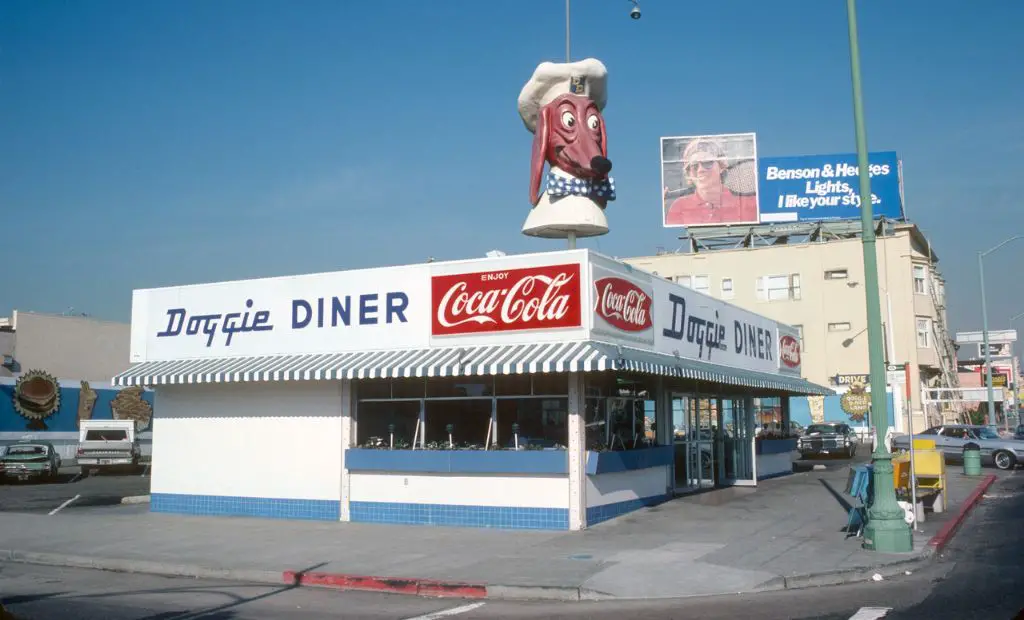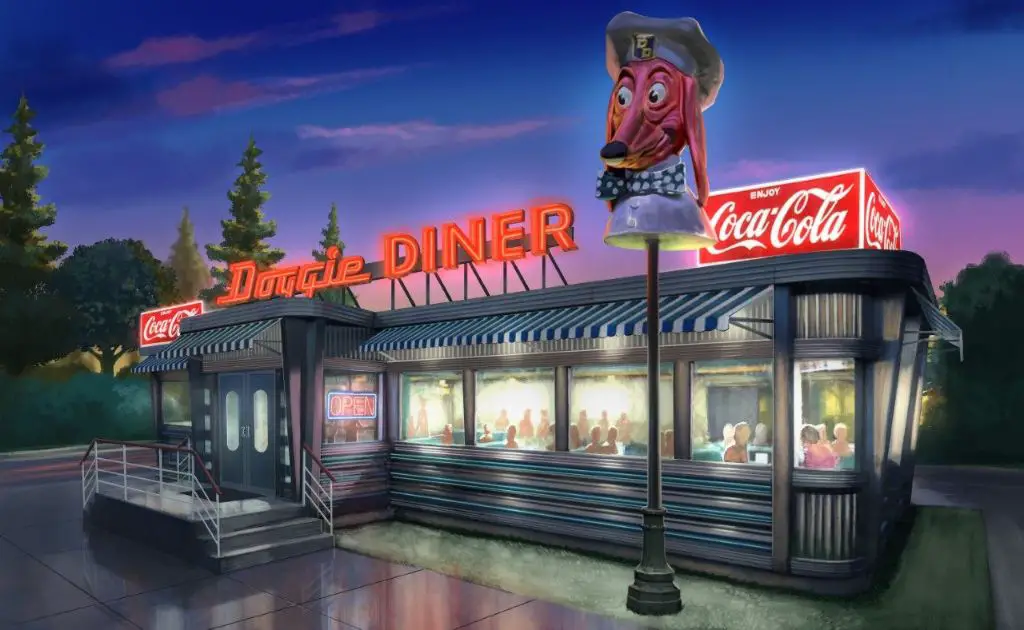Introduction
The Doggie Diner restaurant chain has a unique place in San Francisco Bay Area history and culture. Though the last location closed in 1986, the restaurant’s giant rotating hot dog head sign and mascot “Doggie Diner Dog” remain beloved icons of mid-20th century Americana. This fast food chain was started in 1948 by Al Ross, who sought to provide quality fast food at affordable prices. At its peak, Doggie Diner had over 30 locations in the Bay Area. Though the restaurants are gone, the memory of Doggie Diner persists through its iconic signage and place in the public imagination.
Origins
Doggie Diner was founded in San Francisco in the 1930s during the Great Depression. Entrepreneur Al Ross opened the first location on Van Ness Avenue as a walk-up diner focused on serving hot dogs and hamburgers at affordable prices. The diner was a big hit among working class San Franciscans struggling during the economic downturn. Its trademark rotating mechanized chef sign was installed in front of the original location, quickly becoming a beloved city icon.

Over the next few decades, Doggie Diner expanded across San Francisco, bringing its trademark diner fare and rotating chef signage to new neighborhoods. Additional diners opened up in Oakland and other parts of the Bay Area as well. Doggie Diner became a staple of San Francisco culture over the mid-20th century.
Growth
Doggie Diner expanded across the San Francisco Bay Area in the 1950s and 1960s. According to the Original Doggie Diner website, at one point there were over 30 Doggie Diner locations throughout the region, including Oakland, San Francisco, Marin County, San Mateo, and other areas around the bay. The chain grew popular for its convenient locations, quality diner food, and eccentric decor featuring a Dachshund mascot.
As noted on the Doggie Diner Wikipedia page, the chain’s expansion was fueled by America’s postwar economic boom and the rise of car culture in the 1950s and 60s. Doggie Diner drive-ins with their signature giant Dachshund heads were a familiar sight to many Bay Area residents during this period.
Decline
The Doggie Diner chain started to decline in the late 1980s as competition from national fast food chains like McDonald’s and Burger King intensified. According to Wikipedia, the last of the Doggie Diners closed in 1986 after the chain went bankrupt. An article on SFGate explains that the rising costs of beef and buns made it difficult for Doggie Diner to compete on price with the larger chains.1 After serving customers for almost 40 years, the final Doggie Diner location closed its doors in 1986.
Legacy
The most iconic and recognizable aspect of Doggie Diner was the giant dachshund head sign that adorned many of their restaurants. The 7-foot tall fiberglass head with a chef’s hat sitting atop a rotating pole became a beloved San Francisco landmark from the 1950s through the 1980s. The googly-eyed mascot with its mechanical wagging tail was designed by Harold Bachman to attract customers. During Doggie Diner’s heyday, at least 30 of the giant signs could be spotted across San Francisco.
![]()
Though the last Doggie Diner restaurant closed in 1986, the iconic dachshund heads live on in the memories of Bay Area residents. Preservationists have saved a few of the original signs, one of which sits at the corner of 17th and Vermont Streets in the Mission District. The dachshund mascot remains a nostalgic symbol of San Francisco’s history.
Source: https://en.wikipedia.org/wiki/Doggie_Diner
Preservation
Several of the iconic Doggie Diner heads have been preserved in museums and public locations around San Francisco. The large rotating head that stood outside the last operating Doggie Diner location was restored by the city of San Francisco and installed on a median at Sloat Boulevard and 45th Avenue in 2001, according to Wikipedia (https://en.wikipedia.org/wiki/Doggie_Diner). Another restored head is on display at the San Francisco International Airport, while additional heads can be found at the Musee Mecanique at Fisherman’s Wharf and in Doggie Diner, Inc.’s corporate offices.

These public displays allow Bay Area residents and visitors to connect with the nostalgia and kitschiness of the Doggie Diner brand, even though the restaurants themselves have closed. The recognizable fiberglass heads serve as icons of San Francisco’s past and have taken on a significance beyond just advertising the Doggie Diners.
Nostalgia
Even though the last Doggie Diner closed in 1986, the oversized Doggie heads have remained a cultural icon representing San Francisco’s history and nostalgia for a bygone era. The giant heads were designed by Harold Bachman to be noticeable to passing cars and became landmarks across the city.
Though the diners are gone, the Doggie heads still provoke fond memories for long-time San Francisco residents. As noted in the Wikipedia article about Doggie Diner, “The Doggie Diner heads have since become icons of San Francisco kitsch.” Wikipedia. The Doggie heads are immediately recognizable and often used in marketing and branding that tries to tap into San Franciscans’ nostalgia.
Fans of Doggie Diner still feel a strong attachment to the oversized pup that represented a fun, affordable dining option. Though fast food, the chain offered higher quality items like apple pie, leading to enduring affection from its fan base. The Doggie head sculptures serve as physical reminders of retro San Francisco and the down-home dining of decades past.
Possibility of Revival
There has been some interest in reviving Doggie Diner over the years, but no concrete plans have yet come to fruition. In 2019, Napa resident Kip Atchley announced plans to resurrect the chain after acquiring the trademark rights and drafting business plans, but the revival has not yet happened as of early 2023 (Source). Atchley grew up nearby Doggie Diner’s original locations and was motivated by nostalgia to bring the brand back. However, reviving a classic brand comes with many challenges.

While Doggie Diner retains strong name recognition and nostalgia value, especially with Baby Boomers who grew up with the chain, the operational challenges of reviving a defunct restaurant brand are immense. Significant capital, strategic planning, marketing, and commitment would be required to successfully pull off a revival. With no news since the initial announcement in 2019, it appears the Doggie Diner revival remains an uncertain prospect for now.
Challenges
Reviving an iconic brand like Doggie Diner would come with several challenges. The biggest would likely be the cost. According to an article on restaurant rebranding from GrubHub, the average cost of refreshing a restaurant’s branding is between $25,000-$250,000 depending on size and scope (get.grubhub.com/blog/restaurant-rebranding/). Considering Doggie Diner was a popular chain with multiple locations, reestablishing the brand after several decades would require a significant investment.
Another hurdle would be adapting to changing consumer tastes over time. Doggie Diner’s kitschy aesthetic and diner fare may seem dated to modern diners. As an article in the Journal of Marketing notes, revived brands must find the right balance between leveraging nostalgia while also feeling fresh and contemporary (journals.sagepub.com/doi/10.1509/jmkg.67.3.19.18657). Doggie Diner would need to reimagine itself to appeal to today’s consumers.
Finally, the competitive restaurant landscape in San Francisco poses a challenge. With so many dining options today, from food trucks to Michelin-star establishments, Doggie Diner would need to differentiate itself and give customers a compelling reason to choose it over all the other choices. Overall, while revival is possible, it would require creative solutions to overcome these roadblocks.
Conclusion
Despite the enduring nostalgia for Doggie Diner among San Francisco locals, a full return of the iconic chain seems unlikely. The brand’s signature rotating hot dog sign and plastic dog head mascot represent a certain kitschiness inextricable from mid-20th century Americana. While Doggie Diner maintains an outsized presence in the city’s collective memory and popular imagination, the realities of the modern quick service industry pose challenges to reviving a restaurant brand predicated on novelty and nostalgia.
Still, the Doggie Diner logo and aesthetic continue to make cameos in San Francisco culture. Tattoos and t-shirts celebrating Doggie Diner proliferate, speaking to locals’ pride in the city’s idiosyncratic institutions and history. As long as San Franciscans remain charmed by the cheeky grins of those giant fiberglass dachshund heads, the spirit of Doggie Diner lives on.